
|
It was expected to reach up to 7 mag and to be observable in good condition in winter. However, this comet has not been observed since 1986. It was not detected, fainter than 17.2 mag on Oct. 18 (Katsumi Yoshimoto), and fainter than 20 mag on Nov. 3 (Gustavo Muler). It seems much fainter than expected. The condition of this apparition is good. It keeps observable for a long time until 2009 early summer both in the Northern Hemisphere and Southern Hemisphere.
Date(TT) R.A. (2000) Decl. Delta r Elong. m1 Best Time(A, h)
Nov. 29 21 39.86 -10 37.3 0.901 1.173 76 7.6 20:40 (103, 36)
Dec. 6 22 3.48 -7 57.6 0.889 1.157 76 7.3 20:48 (104, 32)
|
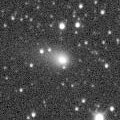
|
Now it is 8.5 mag (Oct. 25, Marco Goiato). It is expected to reach to 4 mag in 2009 February. It is not observable now. But it will appear in the morning sky again at 7 mag in late December. Then it keeps observable in the excellent condition long time around the highlight until spring.
Date(TT) R.A. (2000) Decl. Delta r Elong. m1 Best Time(A, h)
Nov. 29 16 10.27 -20 5.1 2.364 1.380 2 7.9 2:56 (312,-18)
Dec. 6 16 8.94 -20 2.7 2.291 1.333 10 7.6 2:53 (307,-13)
|
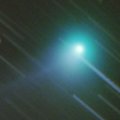
|
It reached to 6.3 mag in September in the southern sky (Sept. 4, Marco Goiato). Now it is still bright as 8.7 mag (Nov. 22, Seiichi Yoshida). It keeps locating in the evening low sky until the end of 2008 when it fades out down to 10 mag. Then it turns to appear in the morning sky, and it keeps observable in the northern sky after that while fading gradually. In the Southern Hemisphere, it will never be observable again.
Date(TT) R.A. (2000) Decl. Delta r Elong. m1 Best Time(A, h)
Nov. 29 17 47.60 7 54.3 2.126 1.454 36 8.8 20:40 ( 84,-22)
Dec. 6 18 1.25 10 58.2 2.185 1.527 37 9.0 20:48 ( 84,-28)
|

|
Brightening very rapidly, faster than expected. It is already so bright as 9.7 mag (Nov. 29, Maik Meyer). Strongly condensed and easy to see. It is expected to reach to 8 mag in 2009 summer. Because it moves in the northern sky, it keeps observable until it becomes brightest in the Northern Hemisphere.
Date(TT) R.A. (2000) Decl. Delta r Elong. m1 Best Time(A, h)
Nov. 29 21 58.63 57 55.1 3.385 3.766 105 10.2 20:40 (156,-11)
Dec. 6 21 56.04 54 55.6 3.419 3.730 100 10.2 20:48 (150,-13)
|

|
Now it is bright as 10.8 mag (Nov. 23, Seiichi Yoshida). It keeps observable in good conditioni as bright as 11 mag until January. Then, it keeps observable, visible visually, brighter than 14 mag for a long time until 2009 May.
Date(TT) R.A. (2000) Decl. Delta r Elong. m1 Best Time(A, h)
Nov. 29 6 41.58 61 1.3 1.784 2.565 133 10.7 2:10 (180, -6)
Dec. 6 6 35.81 60 35.5 1.774 2.590 137 10.8 1:37 (180, -6)
|

|
It reached up to 8.5 mag in September (Sept. 24, Juan Jose Gonzalez). Diffuse object expanding a large coma. It is still bright as 10.6 mag (Nov. 27, Marco Goiato). In the Northern Hemisphere, it locates extremely low now. Although it will be getting higher slowly after this, it will be fading rapidly. However, it keeps observable in the evening sky until it becomes fainter than 18 mag early 2009.
Date(TT) R.A. (2000) Decl. Delta r Elong. m1 Best Time(A, h)
Nov. 29 0 8.37 -26 37.5 1.299 1.790 102 11.4 20:40 (117, 74)
Dec. 6 0 20.40 -24 29.2 1.400 1.837 99 11.9 20:48 (113, 68)
|

|
It has brightened much faster than expected. It was so faint as 20 mag in early September, and it was still faint as 16.1 mag on Nov. 1 (Ken-ichi Kadota), however, it became so bright and visible visually at 12.2 mag on Nov. 16 (Juan Jose Gonzalez). It will reach up to 10-11 mag in January. Then it keeps observable in good condition and visible visually for a long time until next spring.
Date(TT) R.A. (2000) Decl. Delta r Elong. m1 Best Time(A, h)
Nov. 29 3 19.60 19 8.1 0.609 1.583 165 12.4 22:44 (180, 36)
Dec. 6 3 17.90 18 12.1 0.595 1.553 157 11.9 22:15 (180, 37)
|

|
Not recovered yet. It must be brightening very rapidly in the evening sky. However, it was not detected, fainter than 18 mag, on Nov. 22 (Maik Meyer). It is expected to reach up to 7.5 mag in January, but actually it may be much fainter than expected. It is not observable for about a month around the highlight. In the Northern Hemisphere, it keeps locating low in the evening sky until the highlight. But it turns to appear in the morning sky after February, then it keeps observable in good condition while fading gradually. In the Southern Hemisphere, it locates high except for January.
Date(TT) R.A. (2000) Decl. Delta r Elong. m1 Best Time(A, h)
Nov. 29 20 5.06 -28 25.2 1.214 0.967 50 13.2 20:40 ( 72, 26)
Dec. 6 20 20.69 -27 26.8 1.139 0.866 47 12.3 20:48 ( 71, 21)
|

|
It brightened up to 11.5 mag in summer (Aug. 4, Marco Goiato). It keeps bright at 12 mag for a long time until 2009 spring. However, it is not observable in the Northern Hemisphere now. It will appear in the northern sky again in 2009 autumn, but it will be fainter than 15 mag and will keep locating very low after that. In the Southern Hemisphere, it keeps observable for a long time until it fades out, although it becomes low in autumn.
Date(TT) R.A. (2000) Decl. Delta r Elong. m1 Best Time(A, h)
Nov. 29 16 32.17 -58 6.4 3.375 2.651 36 12.4 20:40 ( 24, 12)
Dec. 6 16 45.80 -60 3.3 3.367 2.655 37 12.4 2:53 (338, 13)
|

|
It reached to 10.9 mag in May (May 11, Marco Goiato). Now it is fading slowly. It has faded down to 12.0 mag on July 21 (Alexandre Amorim). Now it is appearing in the morning sky after a long blank. It keeps bright as 12-14 mag for a long time after this until 2009 summer.
Date(TT) R.A. (2000) Decl. Delta r Elong. m1 Best Time(A, h)
Nov. 29 14 57.44 0 56.1 3.964 3.151 30 12.8 2:56 (282,-19)
Dec. 6 15 7.65 1 33.0 3.944 3.186 34 12.8 2:53 (280,-16)
|

|
Already bright as 13.5 mag, and visible visually (Oct. 7, Alan Hale). It is extremely low in the Northern Hemisphere now, but observable in good condition in the Southern Hemisphere. It is expected to brighten up to 10 mag from late 2009 to early 2010. Because the comet moves in the southern sky for a long time, it keeps impossible or very hard to observe in the Northern Hemisphere until 2009 September. But after 2009 October, it is observable at 10 mag for a while in good condition. In the Southern Hemisphere, it keeps observable for a long time while brightening until 2009 June when it brightens to 11 mag. But it becomes unobservable around and after the brightest time.
Date(TT) R.A. (2000) Decl. Delta r Elong. m1 Best Time(A, h)
Nov. 29 6 8.23 -53 49.0 3.724 4.034 101 13.2 1:36 ( 0, 71)
Dec. 6 6 2.53 -54 10.1 3.657 3.978 101 13.1 1:03 ( 0, 71)
|
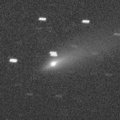
|
It reached up to 9.6 mag in summer (Aug. 2, Juan Jose Gonzalez). Now it is fading. It has already faded down to 12.5 mag (Nov. 22, Seiichi Yoshida). It keeps observable and fading in the morning sky after this. It keeps brighter than 14 mag and visible visually until the end of 2008. In the Southern Hemisphere, it keeps extremely low, or under the horizon, so it will not be observable.
Date(TT) R.A. (2000) Decl. Delta r Elong. m1 Best Time(A, h)
Nov. 29 12 38.31 26 13.7 2.029 1.963 71 13.3 2:56 (242, -5)
Dec. 6 12 51.65 26 20.9 2.014 2.012 75 13.5 2:53 (240, -3)
|

|
An large outburst occured on Sept. 21, and it became so bright as 11.3 mag (Juan Antonio Henriquez Santana). The total brightness reached up to 10.3 mag in October (Oct. 11, Maik Meyer). It keeps bright as 11.0 mag still now (Nov. 23, Seiichi Yoshida). Now the diameter is over 4 arcmin, looks very large and diffuse.
Date(TT) R.A. (2000) Decl. Delta r Elong. m1 Best Time(A, h)
Nov. 29 8 20.10 22 57.0 5.464 6.083 124 13.6 2:56 (194, 31)
Dec. 6 8 18.72 22 59.9 5.377 6.085 132 13.5 2:53 (187, 32)
|

|
Now it is 14.5 mag, and visible visually (Oct. 26, Juan Jose Gonzalez). It locates near by Polaris until December, and observable all night. It will brighten gradually after this, and reach to 9-10 mag in 2009 June. In the Northern Hemisphere, it keeps observable in good condition until May when it becomes brightest. But it will never be observable again after that. In the Southern Hemisphere, it is not observable until 2009 April. But after that, it will be observable while fading gradually.
Date(TT) R.A. (2000) Decl. Delta r Elong. m1 Best Time(A, h)
Nov. 29 8 48.96 88 58.7 2.463 2.975 111 14.2 2:56 (181,-34)
Dec. 6 1 43.64 89 13.0 2.368 2.899 113 14.0 20:48 (180,-34)
|
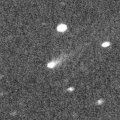
|
Now it is 16.6 mag (Nov. 5, Ken-ichi Kadota). It will brighten rapidly after this. It will be observable at 12-13 mag for a long time from January to July in 2009. But actually, it seems to be fainter than this ephemeris.
Date(TT) R.A. (2000) Decl. Delta r Elong. m1 Best Time(A, h)
Nov. 29 9 49.79 17 33.5 2.275 2.680 103 14.6 2:56 (219, 28)
Dec. 6 9 54.72 17 17.5 2.163 2.655 109 14.4 2:53 (214, 30)
|

|
Diffuse comet, but it brightened up to 9.8 mag on July 7 (Juan Jose Gonzalez). Now it is fading, but still visible visually at 14.1 mag (Nov. 22, Seiichi Yoshida). In the Northern Hemisphere, it keeps observable until 2009 spring when the comet becomes faint. It will move near by the Northern Pole from summer to autumn, and will be observable all night. It will be visible visually for some more time. In the Southern Hemisphere, it will never be observable again.
Date(TT) R.A. (2000) Decl. Delta r Elong. m1 Best Time(A, h)
Nov. 29 1 44.58 77 49.0 1.797 2.452 120 14.5 21:10 (180,-23)
Dec. 6 1 52.43 74 14.6 1.833 2.511 123 14.8 20:51 (180,-19)
|
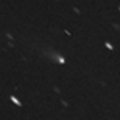
|
Now it is 14.6 mag (Nov. 19, Alan Hale), already visible visually. It will be brightening gradually after this, and reach to 12-13 mag in 2009 winter and spring. In the Northern Hemisphere, it keeps observable for a long time until 2009 May.
Date(TT) R.A. (2000) Decl. Delta r Elong. m1 Best Time(A, h)
Nov. 29 21 37.66 -20 18.4 1.637 1.648 73 14.7 20:40 ( 93, 40)
Dec. 6 21 50.77 -18 42.3 1.651 1.599 69 14.6 20:48 ( 91, 35)
|

|
An outburst occured in late May and it brightened up to 14.6 mag (May 23, Gustavo Muler), but it faded down to the original brightness in late May. Then it had been reported so faint as 17 mag by CCD observations. However, it suddenly became so bright and visible visually after late August, and it reached up to 11.0 mag visually in September (Sept. 24, Juan Jose Gonzalez). However, it is fading now. It locates extremely low in the Northern Hemisphere.
Date(TT) R.A. (2000) Decl. Delta r Elong. m1 Best Time(A, h)
Nov. 29 19 23.01 -32 56.9 2.045 1.465 41 14.6 20:40 ( 63, 20)
Dec. 6 19 50.72 -32 49.2 2.109 1.508 40 14.7 20:48 ( 62, 19)
|
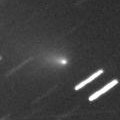
|
It had been lost for 112 years sincd 1896, but re-discovered by Koichi Itagaki and Hiroshi Kaneda on Sept. 10. It should be bright temporarily in outburst now. However, it still keeps bright as 12.6 mag (Nov. 22, Seiichi Yoshida). It keeps locating high in the evening sky for a while after this. It will keep visible visually for some more time.
Date(TT) R.A. (2000) Decl. Delta r Elong. m1 Best Time(A, h)
Nov. 29 23 23.76 -12 24.3 1.270 1.734 99 14.7 20:40 (126, 56)
Dec. 6 23 39.07 -11 33.4 1.362 1.768 96 15.1 20:48 (121, 52)
|

|
It brightened up to 12.7 mag in spring (Apr. 12, Marco Goiato). However, it has already faded down to 14.9 mag (July 22, Mitsunori Tsumura). It will never be observable again in the Northern Hemisphere. It is not observable now also in the Southern Hemisphere, but it will appear again in the morning sky at 15 mag in 2009 January.
Date(TT) R.A. (2000) Decl. Delta r Elong. m1 Best Time(A, h)
Nov. 29 15 55.56 -37 3.9 4.069 3.136 16 14.7 2:56 (320, -3)
Dec. 6 16 9.71 -38 6.4 4.081 3.158 17 14.7 2:53 (319, 0)
|

|
It had been bright and visible visually around 13 mag from spring to autumn in 2008. Now it locates extremely low, and hard to observe. But it will locate high again in winter, and will be visible visually at 14 mag.
Date(TT) R.A. (2000) Decl. Delta r Elong. m1 Best Time(A, h)
Nov. 29 15 10.96 18 46.0 6.721 6.047 43 14.8 2:56 (268,-31)
Dec. 6 15 12.87 19 5.7 6.680 6.066 48 14.8 2:53 (265,-27)
|
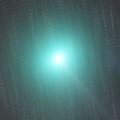
|
It became so bright as 4.7 mag, and so large as 20 arcmin in June (June 12, Marco Goiato). Extremely diffuse, and fading very rapidly now. It was still visible visually at 13.8 mag on Nov. 1 (Seiichi Yoshida). However, it is already so faint as 18.5 mag by CCD observations (Nov. 24, C. Rinner, F. Kugel).
Date(TT) R.A. (2000) Decl. Delta r Elong. m1 Best Time(A, h)
Nov. 29 0 30.63 15 39.6 1.917 2.615 125 14.9 20:40 (166, 38)
Dec. 6 0 33.15 15 28.9 2.082 2.701 119 15.3 20:48 (157, 36)
|

|
An outburst occured in 2008 February, and it brightened up to 16.0 mag (Feb. 28, Mt. Lemmon Survey) although it was predicted to be so faint as 19 mag. It had been reported brighter than predicted until early April. However, it returned to be so faint, fainter than 18 mag, after mid April. Although it has not beeb observable for a while, now it is appearing in the morning sky again. It will be bright at 9-10 mag for a long time from spring to autumn in 2009.
Date(TT) R.A. (2000) Decl. Delta r Elong. m1 Best Time(A, h)
Nov. 29 14 11.75 -9 34.0 3.052 2.291 33 15.3 2:56 (284, -3)
Dec. 6 14 25.75 -10 41.7 2.962 2.249 36 15.1 2:53 (283, 0)
|

|
It was 15 mag on Jan. 14 (Michael Mattiazzo), brightening as expected. It should have reached up to 13.5 mag in summer in the southern sky. Now it is fading. In the Southern Hemisphere, it keeps observable for a long time after this. It is finally appearing in the morning sky also in the Northern Hemisphere soon. It keeps observable while the comet will be fading slowly after this.
Date(TT) R.A. (2000) Decl. Delta r Elong. m1 Best Time(A, h)
Nov. 29 12 6.74 -29 25.2 3.548 3.126 57 15.2 2:56 (286, 32)
Dec. 6 12 11.46 -29 14.8 3.504 3.170 62 15.2 2:53 (283, 36)
|
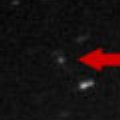
|
Now it is 15.6 mag (Sept. 18, Siding Spring Survey). It will be getting lower in the evening sky, and it will be unobservable in December.
Date(TT) R.A. (2000) Decl. Delta r Elong. m1 Best Time(A, h)
Nov. 29 18 55.16 -16 17.6 2.535 1.842 36 15.3 20:40 ( 74, 6)
Dec. 6 19 14.05 -16 11.8 2.550 1.822 34 15.3 20:48 ( 72, 2)
|
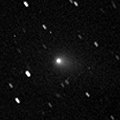
|
It passed near by earth in October. It brightened more rapidly than expected, and then it continues brightening more. Now it is bright as 13.7 mag and visible visually (Nov. 24, Marco Goiato). However, it will fade out rapidly after this. It will be fainter than 18 mag in late December.
Date(TT) R.A. (2000) Decl. Delta r Elong. m1 Best Time(A, h)
Nov. 29 2 58.22 16 52.8 0.487 1.454 159 15.4 22:23 (180, 38)
Dec. 6 3 2.61 17 51.1 0.529 1.479 154 15.8 22:00 (180, 37)
|

|
Now it is 14.2 mag and visible visually (Nov. 22, Seiichi Yoshida). But it starts fading in December, and will get lower in the evening sky in January.
Date(TT) R.A. (2000) Decl. Delta r Elong. m1 Best Time(A, h)
Nov. 29 0 24.90 15 36.1 2.847 3.497 124 15.6 20:40 (164, 38)
Dec. 6 0 14.59 14 34.6 2.992 3.517 114 15.8 20:48 (151, 35)
|

|
Now it is 16.6 mag (Oct. 18, Ken-ichi Kadota). It will be observable at 15 mag in good condition in winter.
Date(TT) R.A. (2000) Decl. Delta r Elong. m1 Best Time(A, h)
Nov. 29 9 44.05 19 37.2 3.270 3.655 105 15.8 2:56 (216, 27)
Dec. 6 9 46.25 19 43.1 3.167 3.650 111 15.7 2:53 (211, 29)
|

|
Now it is 16.2 mag (Oct. 27, Gustavo Muler). It will be observable at 16 mag in good condition from autumn to winter.
Date(TT) R.A. (2000) Decl. Delta r Elong. m1 Best Time(A, h)
Nov. 29 1 59.70 27 46.7 1.585 2.474 147 15.9 21:24 (180, 27)
Dec. 6 1 57.99 27 9.6 1.616 2.458 140 15.9 20:55 (180, 28)
|
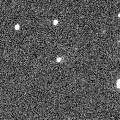
|
Now it is 16.0 mag (Nov. 21, Ken-ichi Kadota). It will brighten up to 12-13 mag in 2010 summer. It reaches to 14.5 mag in 2009 spring, and keeps observable in good condition until 2009 summer.
Date(TT) R.A. (2000) Decl. Delta r Elong. m1 Best Time(A, h)
Nov. 29 12 5.33 10 5.3 3.690 3.481 70 16.1 2:56 (250, 11)
Dec. 6 12 11.67 9 40.7 3.571 3.460 75 16.0 2:53 (247, 15)
|
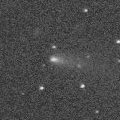
|
Now it is 13.9 mag and visible visually (Nov. 1, Seiichi Yoshida). It will be fading slowly after this. But it keeps observable in good condition until February when it becomes fainter than 18 mag.
Date(TT) R.A. (2000) Decl. Delta r Elong. m1 Best Time(A, h)
Nov. 29 3 10.32 7 16.1 1.259 2.204 157 16.0 22:35 (180, 48)
Dec. 6 3 7.39 7 15.4 1.307 2.220 150 16.2 22:04 (180, 48)
|
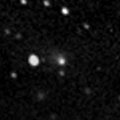
|
Now it is 14.6 mag and visible visually (Aug. 6, Juan Jose Gonzalez). It locates somewhat low in the Northern Hemisphere, but it keeps observable around 15-16 mag until winter.
Date(TT) R.A. (2000) Decl. Delta r Elong. m1 Best Time(A, h)
Nov. 29 21 35.21 -18 20.6 2.947 2.824 73 16.1 20:40 ( 94, 39)
Dec. 6 21 43.41 -17 11.9 3.030 2.819 68 16.2 20:48 ( 91, 33)
|
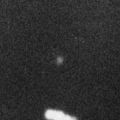
|
Now it is 15.5 mag (Oct. 18, Yasukazu Ikari). It will be too low in the evening sky in January. In 2009, it will be observable at 15 mag in good condition for a long time from summer to autumn.
Date(TT) R.A. (2000) Decl. Delta r Elong. m1 Best Time(A, h)
Nov. 29 22 52.29 -34 3.4 4.383 4.396 84 16.1 20:40 ( 82, 61)
Dec. 6 22 52.59 -32 25.1 4.458 4.369 78 16.1 20:48 ( 81, 53)
|

|
Now it is 15.8 mag (Nov. 23, I. Almendros). It will be fading slowly after this, and will be fainter than 18 mag in March.
Date(TT) R.A. (2000) Decl. Delta r Elong. m1 Best Time(A, h)
Nov. 29 20 21.48 25 0.1 1.918 1.910 74 16.2 20:40 (120, -2)
Dec. 6 20 39.61 25 45.9 1.948 1.915 73 16.3 20:48 (118, -5)
|

|
It recovered as bright as expected, 16.4 mag on Oct. 15 (Ken-ichi Kadota). It will reach up to 16 mag until November, and will be observable in good condition. It keeps observable in the morning sky until January when it will be fainter than 18 mag.
Date(TT) R.A. (2000) Decl. Delta r Elong. m1 Best Time(A, h)
Nov. 29 12 43.59 -12 17.1 1.232 1.006 52 16.5 2:56 (274, 16)
Dec. 6 13 8.26 -14 3.6 1.276 1.047 53 16.7 2:53 (275, 17)
|
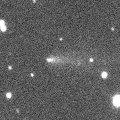
|
It was visible visually at 14.0 mag in autumn (Sept. 7, Juan Jose Gonzalez). Now it is fading, but it keeps observable in good condition until it fades out in winter. Now it is 15.0 mag (Nov. 1, Ken-ichi Kadota), still bright unexpectedly. Maybe a small outburst occured.
Date(TT) R.A. (2000) Decl. Delta r Elong. m1 Best Time(A, h)
Nov. 29 4 22.15 18 42.4 1.279 2.265 177 16.6 23:46 (180, 36)
Dec. 6 4 15.35 18 49.4 1.326 2.304 170 16.9 23:12 (180, 36)
|
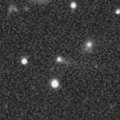
|
It brightened rapidly, and reached to the maximum after the perihelion passage. It was visible visually at 14.8 mag on Sept. 29 (Juan Jose Gonzalez). Now it is fading. It will be fainter than 18 mag in January.
Date(TT) R.A. (2000) Decl. Delta r Elong. m1 Best Time(A, h)
Nov. 29 0 56.98 8 48.4 1.739 2.485 129 16.7 20:40 (174, 46)
Dec. 6 1 1.02 7 43.5 1.832 2.507 122 16.9 20:48 (162, 46)
|

|
At the discovery in 2001, it became much brighter after the perihelion passage. In this apparition, although it was so faint as 20 mag in early September, it has already brightened rapidly up to 17.9 mag (Nov. 23, D. T. Durig, M. H. McManus). It will reach up to 16 mag in January, and will be observable in good condition.
Date(TT) R.A. (2000) Decl. Delta r Elong. m1 Best Time(A, h)
Nov. 29 8 28.69 17 17.9 1.233 1.942 121 17.0 2:56 (198, 36)
Dec. 6 8 34.01 17 29.6 1.175 1.940 127 16.8 2:53 (192, 37)
|
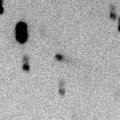
|
Now it is 16.4 mag (Nov. 2, L. Montoro). It brightened rapidly and became brighter than expected. However, it will start fading after December, and will be fainter than 18 mag in January.
Date(TT) R.A. (2000) Decl. Delta r Elong. m1 Best Time(A, h)
Nov. 29 1 34.64 26 59.1 0.854 1.740 141 16.9 21:00 (180, 28)
Dec. 6 1 39.16 26 38.7 0.900 1.751 136 17.0 20:48 (177, 28)
|

|
Now it is 17.4 mag (Sept. 9, Ken-ichi Kadota). It will brighten up to 12 mag in 2012. It is faint still in 2008, but observable at 17 mag in good condition.
Date(TT) R.A. (2000) Decl. Delta r Elong. m1 Best Time(A, h)
Nov. 29 22 37.42 3 11.1 9.918 10.053 95 17.0 20:40 (128, 37)
Dec. 6 22 36.65 2 59.7 10.005 10.016 87 17.0 20:48 (120, 31)
|

|
Now it is 17.6 mag (Nov. 23, Catalina Sky Survey). It will be observable at 15 mag in good condition in 2009 spring.
Date(TT) R.A. (2000) Decl. Delta r Elong. m1 Best Time(A, h)
Nov. 29 11 57.49 19 17.5 2.779 2.718 76 17.4 2:56 (241, 6)
Dec. 6 12 5.66 18 29.6 2.671 2.696 80 17.2 2:53 (239, 10)
|

|
Peculiar asteroid moving along a cometary orbit. It will be observable around 17 mag in good condition for a long time until May. It will fade out very rapidly after May.
Date(TT) R.A. (2000) Decl. Delta r Elong. m1 Best Time(A, h)
Nov. 29 12 12.56 6 41.9 1.551 1.478 67 17.4 2:56 (253, 11)
Dec. 6 12 31.16 5 5.4 1.528 1.495 69 17.4 2:53 (254, 14)
|

|
It was observed at 16.5-17 mag in 2007 autumn. Now it is 17.3 mag (July 2, J. F. Hernandez). It will be fading after this, and will be fainter than 18 mag at the end of 2008.
Date(TT) R.A. (2000) Decl. Delta r Elong. m1 Best Time(A, h)
Nov. 29 4 42.97 27 30.1 1.943 2.924 172 17.4 0:12 (180, 27)
Dec. 6 4 36.37 27 6.0 1.971 2.953 174 17.5 23:33 (180, 28)
|
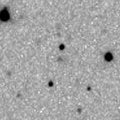
|
Although it was extremely faint as 20 mag in June, it brightened much faster than expected and reached up to 17.1 mag (Oct. 30, P. C. Sherrod). However, it will fade out rapidly after this, and will be fainter than 18 mag in January.
Date(TT) R.A. (2000) Decl. Delta r Elong. m1 Best Time(A, h)
Nov. 29 0 38.07 11 50.8 2.636 3.314 126 17.5 20:40 (168, 42)
Dec. 6 0 39.60 11 26.3 2.725 3.320 119 17.6 20:48 (157, 41)
|
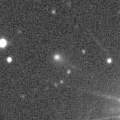
|
It was observed as bright as 14-15 mag in 2007 autumn. Now it is 17.8 mag (Oct. 26, Catalina Sky Survey). It keeps observable in good condition for a while. It will be fainter than 18 mag in Feburary.
Date(TT) R.A. (2000) Decl. Delta r Elong. m1 Best Time(A, h)
Nov. 29 8 25.77 32 5.9 2.738 3.402 125 17.5 2:56 (193, 22)
Dec. 6 8 24.16 32 26.8 2.687 3.428 132 17.5 2:53 (187, 22)
|
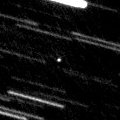
|
Origin of Geminids meteor shower. It is observable in good condition at 17.5 mag from November to December.
Date(TT) R.A. (2000) Decl. Delta r Elong. m1 Best Time(A, h)
Nov. 29 2 24.52 35 8.7 1.411 2.324 151 17.6 21:48 (180, 20)
Dec. 6 2 10.21 33 3.7 1.438 2.304 143 17.7 21:07 (180, 22)
|
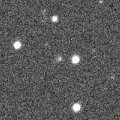
|
Now it is 18.1 mag (Nov. 23, Ken-ichi Kadota). It will brighten up to 15 mag in 2009 and 2010.
Date(TT) R.A. (2000) Decl. Delta r Elong. m1 Best Time(A, h)
Nov. 29 21 16.59 14 8.1 4.116 4.076 80 17.7 20:40 (120, 15)
Dec. 6 21 15.47 14 0.8 4.182 4.029 74 17.7 20:48 (114, 9)
|

|
Now it is 17.5 mag (Nov. 5, Ken-ichi Kadota). It will be fainter than 18 mag in late December.
Date(TT) R.A. (2000) Decl. Delta r Elong. m1 Best Time(A, h)
Nov. 29 1 25.49 7 54.8 1.716 2.518 135 17.7 20:50 (180, 47)
Dec. 6 1 25.49 8 17.9 1.778 2.515 128 17.8 20:48 (171, 46)
|

|
It reached up to 16 mag last winter. Now it is 17.7 mag (Nov. 19, Ken-ichi Kadota). It will be fainter than 18 mag in late December.
Date(TT) R.A. (2000) Decl. Delta r Elong. m1 Best Time(A, h)
Nov. 29 4 39.46 19 12.5 4.952 5.936 175 17.7 0:08 (180, 36)
Dec. 6 4 34.93 19 37.6 4.988 5.971 175 17.8 23:32 (180, 35)
|

|
Now it should be brightest. But it has not been recovered yet. It was observed only around the perihelion at the discovery in 1999. If it was bright temporarily in outburst, it can be much fainter than this ephemeris in this apparition. Josef Mueller reported it was 19.2 mag on Dec. 16, 2007, but it was not confirmed.
Date(TT) R.A. (2000) Decl. Delta r Elong. m1 Best Time(A, h)
Nov. 29 6 40.84 24 55.7 2.429 3.305 147 17.8 2:09 (180, 30)
Dec. 6 6 37.00 24 52.4 2.383 3.306 155 17.8 1:38 (180, 30)
|
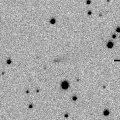
|
It was bright as 16.5 mag on Aug. 31 (Michael Jager). But it has alraedy faded down to 17.5 mag (Oct. 5, C. Rinner, F. Kugel). It will be fainter than 18 mag in December.
Date(TT) R.A. (2000) Decl. Delta r Elong. m1 Best Time(A, h)
Nov. 29 11 21.05 12 16.6 1.734 1.854 80 17.9 2:56 (240, 18)
Dec. 6 11 30.02 11 36.6 1.704 1.902 85 18.0 2:53 (238, 21)
|
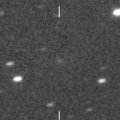
|
Now it is 17.5-18.0 mag (Nov. 9, Michael Jager). It keeps observable at 18 mag in good condition until February.
Date(TT) R.A. (2000) Decl. Delta r Elong. m1 Best Time(A, h)
Nov. 29 11 6.74 30 10.2 2.164 2.399 91 17.9 2:56 (225, 7)
Dec. 6 11 16.21 30 36.6 2.109 2.422 96 17.9 2:53 (222, 9)
|

|
Great outburst occured in 2007 October, and it bacame a naked eye comet of 2 mag. It kept so bright as 5.5 mag still in 2008 spring (Apr. 30, Carlos Labordena), but it was extremely faint and difficult to see. The size was so large, the diameter was larger than 60 arcmin. It will become observable in good condition in this autumn and winter again. The extremely faint large diffuse glow may be detected with a best sky condition, around 5-6 mag with a diameter of 1 or 2 degrees. Mitsunori Tsumura detected a possible glow of Comet Holmes on Nov. 4. Current brightness of the central core is 17.8 mag (Oct. 31, Ken-ichi Kadota), much brighter than pre-outburst brightness still now.
Date(TT) R.A. (2000) Decl. Delta r Elong. m1 Best Time(A, h)
Nov. 29 9 21.68 25 24.8 3.581 4.052 111 18.4 2:56 (208, 24)
Dec. 6 9 20.86 25 29.3 3.506 4.075 118 18.4 2:53 (202, 26)
|

|
It was predicted to be so bright as 14 mag from spring to summer in 2008. But actually, it was extremely faint as 19.5 mag (Aug. 4, Gustavo Muler). Although it locates in good condition, it will be hard to observe.
Date(TT) R.A. (2000) Decl. Delta r Elong. m1 Best Time(A, h)
Nov. 29 22 33.54 9 53.7 2.994 3.257 96 21.5 20:40 (132, 31)
Dec. 6 22 40.14 9 54.5 3.143 3.315 91 21.6 20:48 (126, 27)
|

|
It was observed bright at 16.5-17 mag from late 2006 to early 2007. However, it is fading after that, although it is getting closer to the sun. It was so faint as 19.4 mag around the perihelion passage in 2008 spring (Mar. 10, Mitsunori Tsumura). This comet was observed so faint around the perihelion passage in the previous apparition at the discovery. It faded out before the perihelion passage again in this apparition.
Date(TT) R.A. (2000) Decl. Delta r Elong. m1 Best Time(A, h)
Nov. 29 11 34.39 17 7.3 4.354 4.295 80 21.5 2:56 (239, 12)
Dec. 6 11 39.03 17 8.8 4.256 4.301 85 21.6 2:53 (236, 15)
|
|
![]()
 C/2007 N3 ( Lulin )
C/2007 N3 ( Lulin ) C/2008 A1 ( McNaught )
C/2008 A1 ( McNaught ) C/2006 W3 ( Christensen )
C/2006 W3 ( Christensen ) C/2006 OF2 ( Broughton )
C/2006 OF2 ( Broughton ) 6P/d'Arrest
6P/d'Arrest 144P/Kushida
144P/Kushida P/2003 K2 ( Christensen )
P/2003 K2 ( Christensen ) C/2007 G1 ( LINEAR )
C/2007 G1 ( LINEAR ) C/2006 Q1 ( McNaught )
C/2006 Q1 ( McNaught ) C/2007 Q3 ( Siding Spring )
C/2007 Q3 ( Siding Spring ) 19P/Borrelly
19P/Borrelly 29P/Schwassmann-Wachmann 1
29P/Schwassmann-Wachmann 1 C/2008 T2 ( Cardinal )
C/2008 T2 ( Cardinal ) 116P/Wild 4
116P/Wild 4 C/2008 J1 ( Boattini )
C/2008 J1 ( Boattini ) 67P/Churyumov-Gerasimenko
67P/Churyumov-Gerasimenko 7P/Pons-Winnecke
7P/Pons-Winnecke 205P/2008 R6 ( Giacobini )
205P/2008 R6 ( Giacobini ) C/2007 B2 ( Skiff )
C/2007 B2 ( Skiff ) C/2005 L3 ( McNaught )
C/2005 L3 ( McNaught ) C/2007 W1 ( Boattini )
C/2007 W1 ( Boattini ) 22P/Kopff
22P/Kopff C/2006 U6 ( Spacewatch )
C/2006 U6 ( Spacewatch ) 68P/Klemola
68P/Klemola P/2008 Q2 ( Ory )
P/2008 Q2 ( Ory ) C/2007 U1 ( LINEAR )
C/2007 U1 ( LINEAR ) 74P/Smirnova-Chernykh
74P/Smirnova-Chernykh 59P/Kearns-Kwee
59P/Kearns-Kwee 65P/Gunn
65P/Gunn 61P/Shajn-Schaldach
61P/Shajn-Schaldach 47P/Ashbrook-Jackson
47P/Ashbrook-Jackson C/2008 P1 ( Garradd )
C/2008 P1 ( Garradd ) C/2008 R3 ( LINEAR )
C/2008 R3 ( LINEAR ) 207P/2008 T5 ( NEAT )
207P/2008 T5 ( NEAT ) 51P/Harrington
51P/Harrington P/2008 L2 ( Hill )
P/2008 L2 ( Hill ) 204P/2008 R5 ( LINEAR-NEAT )
204P/2008 R5 ( LINEAR-NEAT ) P/2008 QP20 ( LINEAR-Hill )
P/2008 QP20 ( LINEAR-Hill ) C/2006 S3 ( LONEOS )
C/2006 S3 ( LONEOS ) 77P/Longmore
77P/Longmore 2001 TX16
2001 TX16 44P/Reinmuth 2
44P/Reinmuth 2 200P/2008 L1 ( Larsen )
200P/2008 L1 ( Larsen ) 188P/2007 J7 ( LINEAR-Mueller )
188P/2007 J7 ( LINEAR-Mueller ) (3200) Phaethon
(3200) Phaethon C/2008 N1 ( Holmes )
C/2008 N1 ( Holmes ) P/2008 T4 ( Hill )
P/2008 T4 ( Hill ) C/2006 K1 ( McNaught )
C/2006 K1 ( McNaught ) P/1999 XN120 ( Catalina )
P/1999 XN120 ( Catalina ) 201P/2008 Q4 ( LONEOS )
201P/2008 Q4 ( LONEOS ) 33P/Daniel
33P/Daniel 17P/Holmes
17P/Holmes C/2007 K3 ( Siding Spring )
C/2007 K3 ( Siding Spring ) 173P/2005 T1 ( Mueller 5 )
173P/2005 T1 ( Mueller 5 )![]()












































